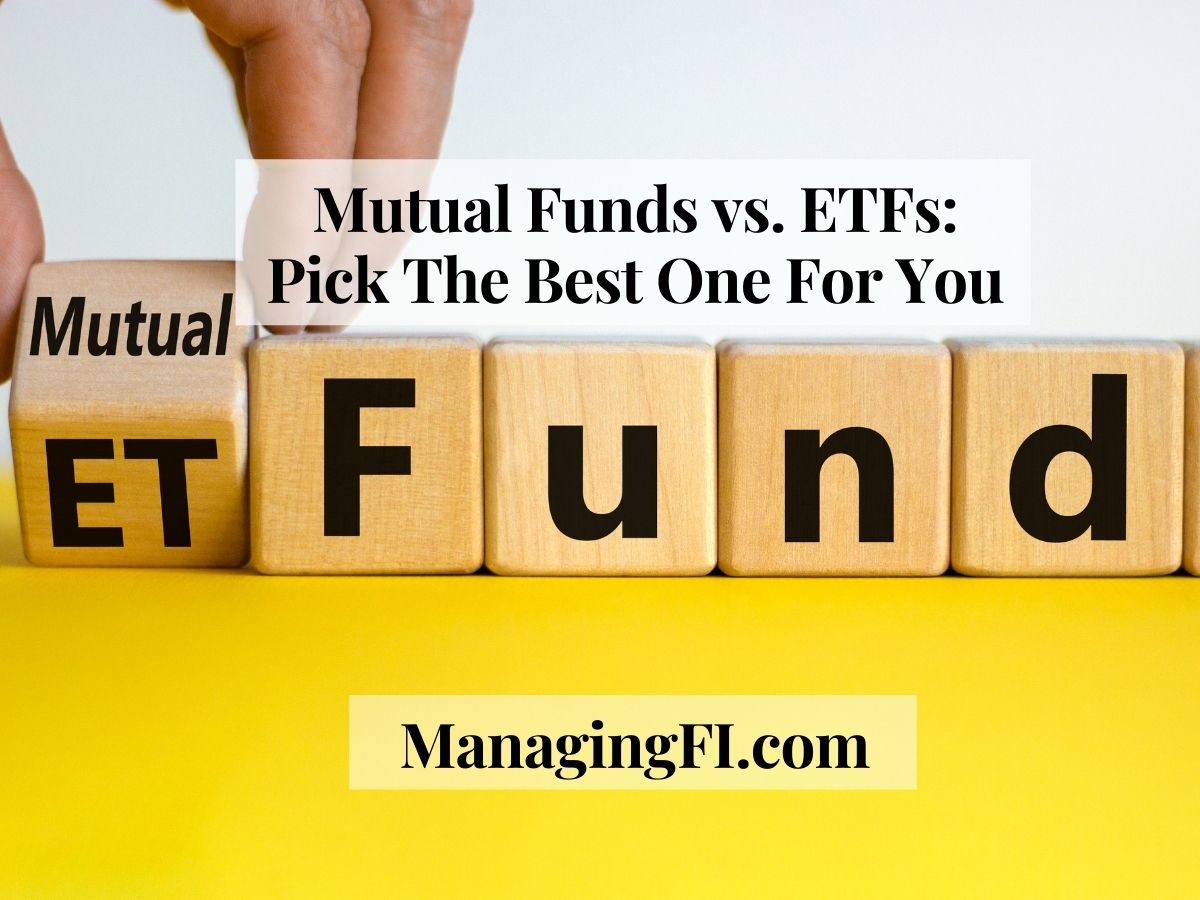BLUF: Mutual Funds and ETFs are the foundation of many portfolios. However, they do differ in tax treatment, ease of automation, liquidity, portability and fees. Educate yourself and choose the right tool for your situation.
No matter where you are on your investing journey you’ve likely heard the terms mutual fund and ETF before at some point. While on the surface these may seem like investing basics, it’s important to understand what each are, how they work, their strengths and their weaknesses.
Knowing this information allows us to decide which one makes the most sense in our individual investment situation. This includes understanding tax implications, ease of automation, portability, investment minimums and liquidity.
Basic Definitions – Fund, Index, Index Fund, Mutual Fund, Exchange Traded Fund (ETF)
Before we get into the technical weeks of mutual funds and ETFs, lets ground ourselves with what these building block terms mean.
What Is A Fund?

Very simply, a fund is money that is pooled together for a specific reason. In investing this means investors pooling their money together to purchase some kind of investment where they hope to receive a return.
If you and your friends wanted to pool your money together and buy a rental property together that would technically be a fund.
We often hear this word used for a variety of different investment vehicles: index fund, mutual fund, exchange traded fund (ETF) and hedge fund.
What Is An Index?
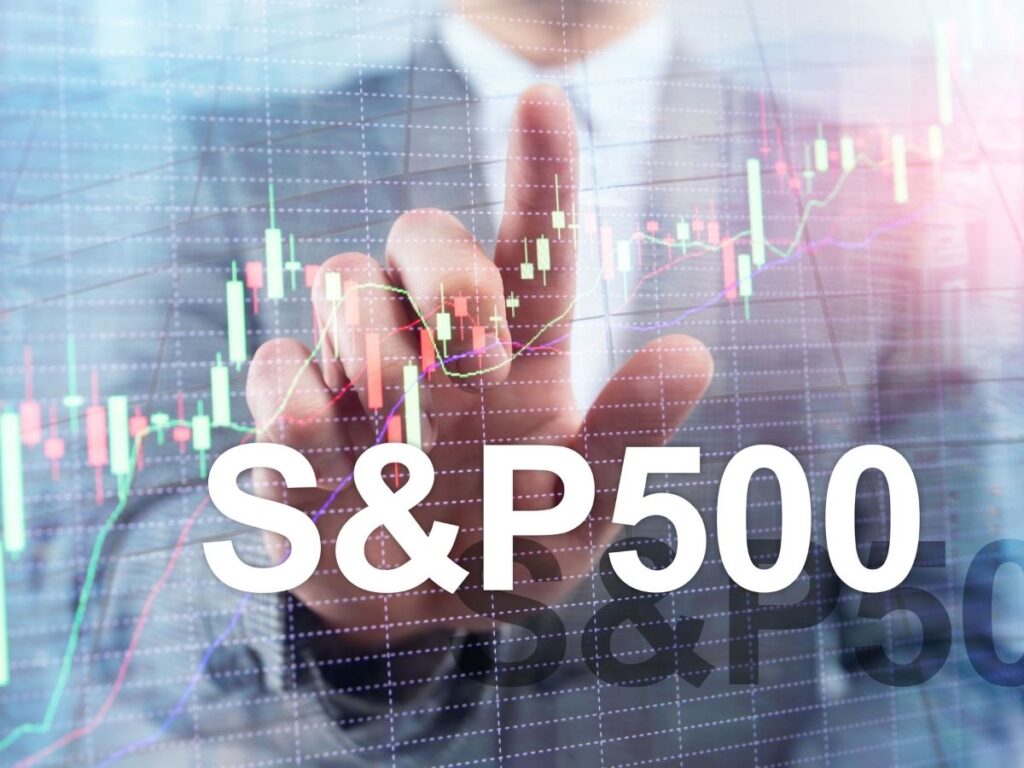
An index in finance is a way to measure the performance of some basked of financial instruments. For average investors this usually means measuring a basket of securities like stocks or bonds.
An index isn’t an investment, it’s just a way to track a group of investible things to see how well they perform. For example, I could create the New York Stock Index that includes every publicly traded company that is headquartered in New York State. You can create an index for anything.
Two of the most famous stock indices in the US are the Dow Jones Industrial Average (DJIA) and the Standard & Poors 500 (S&P 500). They each have different rules and criteria for which companies qualify to be in the index. For example, the S&P 500 is the 500 large cap companies that meet the criteria of that index.
Indexes are created by companies and are most commonly used for two things:
- To create a performance benchmark that other investments or investors
- To create index funds that investors can invest directly in.
What Is An Index Fund?
An index is great, but you can’t buy an index. An index fund isn’t actually a financial instrument. It’s shorthand for either an index mutual fund or index exchange traded fund (ETF) which we’ll talk about shortly.
Mutual funds and ETFs are the real financial instruments that you can buy and sell. When people say index fund just know that they’re talking about either a mutual fund or ETF that lets them invest in an index.
For example, we previously mentioned the S&P500 index. Vanguards mutual fund that tracks the S&P500 is VFIAX.
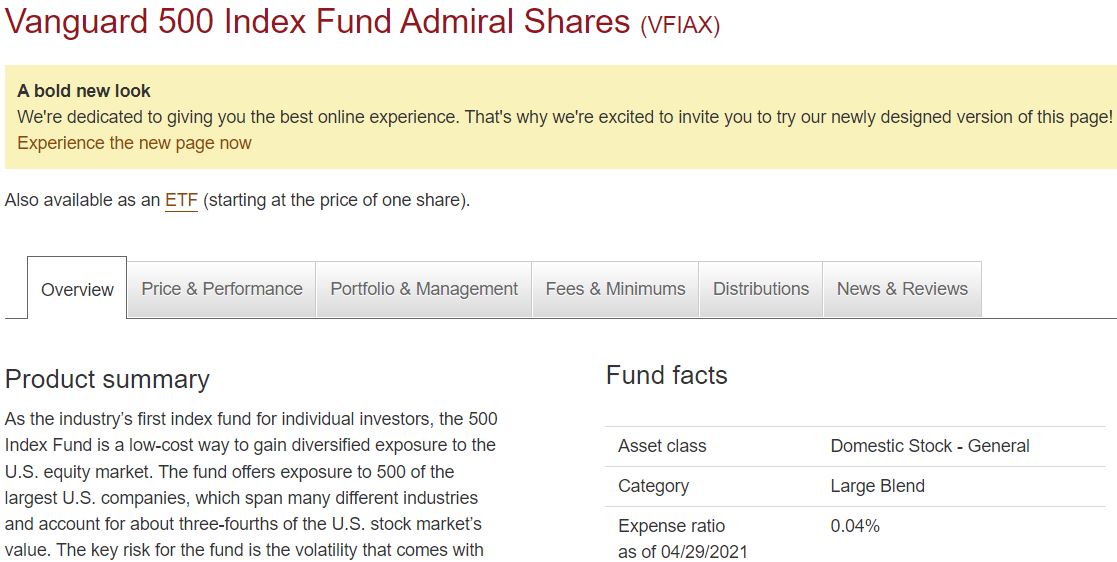
They also have an ETF equivalent that tracks the same index.
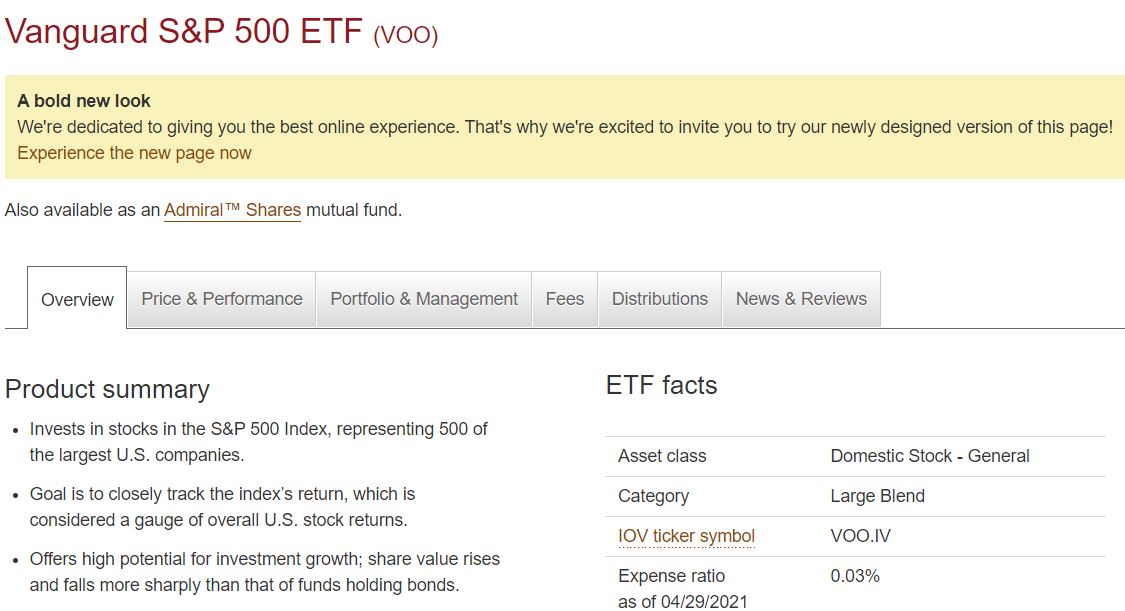
What Is A Mutual Fund?
A mutual fund is a basket of stocks or bonds that are purchased by a professional manager using a pool of investor money. Mutual funds have been around since the 1920’s. The professional manager uses investor money to buy different assets based on the goal of that particular fund.
I’ll go into more specifics about mutual funds including their pros and cons when I talk about the similarities and differences with ETF’s.
What Is An Exchange Traded Fund (ETF)?
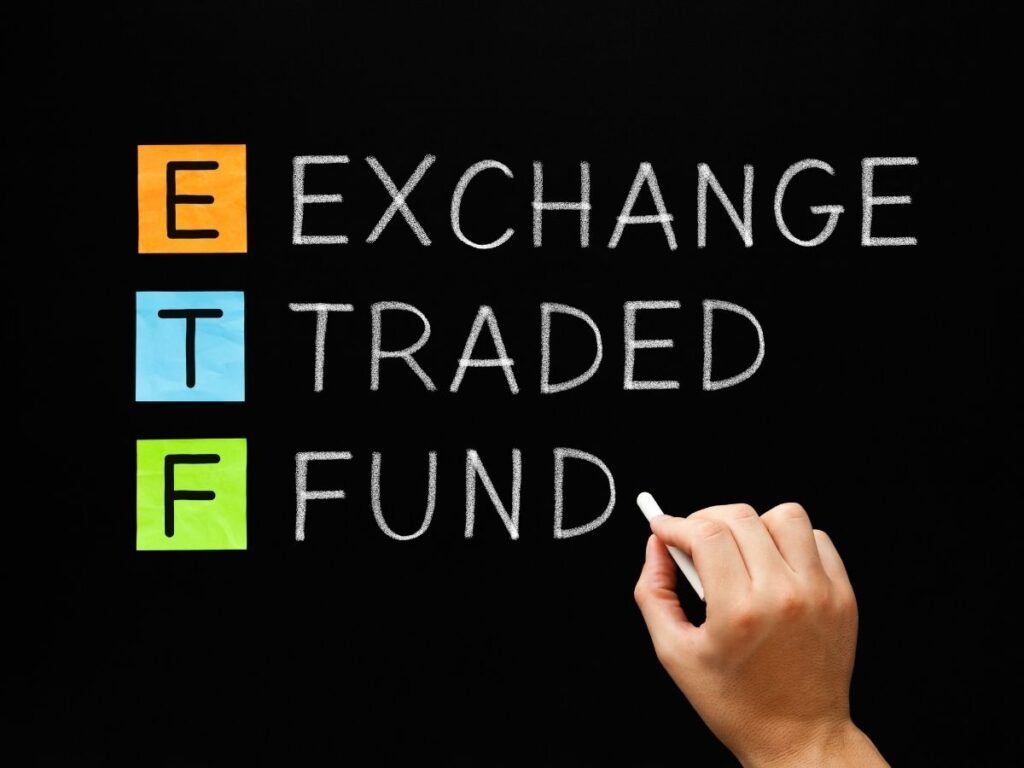
Similar to a mutual fund, an ETF is also a fund where a basket of stocks or bonds that are purchased by a professional manager using a pool of investor money. The differences lie in how they implement that fund with most of detail happening behind the scenes and unknown to the investor.
The first ever ETF was created in 1993 and was an S&P500 index ETF with the ticker SPY. So, these are a much more recent invention compared to the mutual fund. However, they’ve exploded in popularity for reasons that we’ll get into soon.
You can think of the mutual funds versus ETFs like the difference between your 401k and a taxable brokerage account. They both let you buy and sell investments but the rules around taxation, when and how the money can go in and out of the accounts are very different.
It’s not really important for us to know how the sausage is made behind the scenes. Just to know how ETFs are another type of fund with some distinct feature differences that we’ll get into now.
Mutual Fund and Exchange Traded Fund (ETF) – The Similarities
Normally I would describe each of these tradable securities separately in detail but each of these fund types has a lot of similarities to the average investor.
Assets Held:
Mutual funds and ETFs are capable of holding the same stocks, bonds, commodities and other alternative investments inside of them. An S&P500 mutual fund is going to hold the exact same 500 US companies inside of it as an ETF that tracks the S&P500 index.
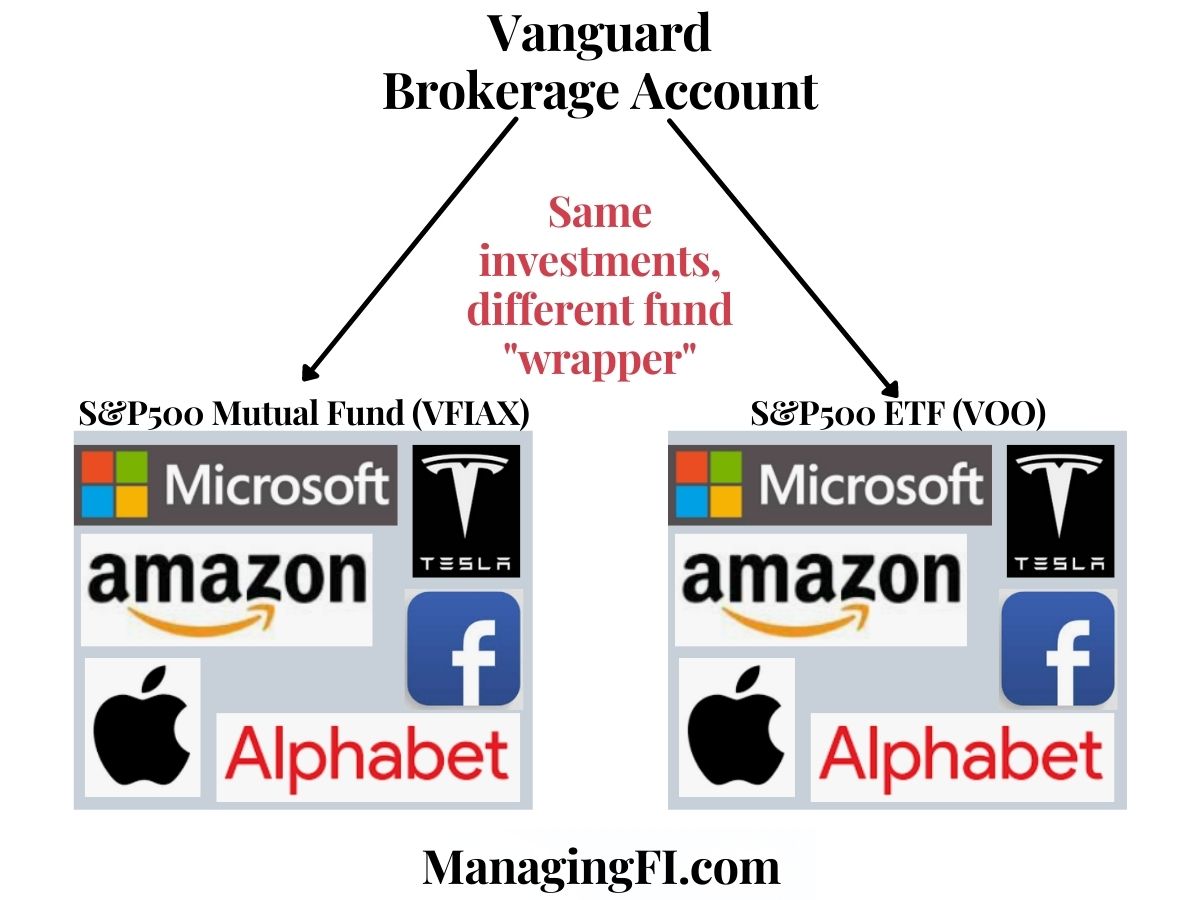
Types Of Funds Available
All the major stock and bond indexes for both US and international are available in both mutual fund and ETF form. You can see many examples of this ability to hold the same thing in both mutual fund and ETF form in the Vanguard fund lineup.

Across the big 3 investment brokerage companies you can fortunately find similar stock and bond index options to build a great portfolio. Here are some helpful guides to show you which mutual fund and ETF options are available at these brokerages. Share them with your friends!
Cheat sheet for stock index funds:
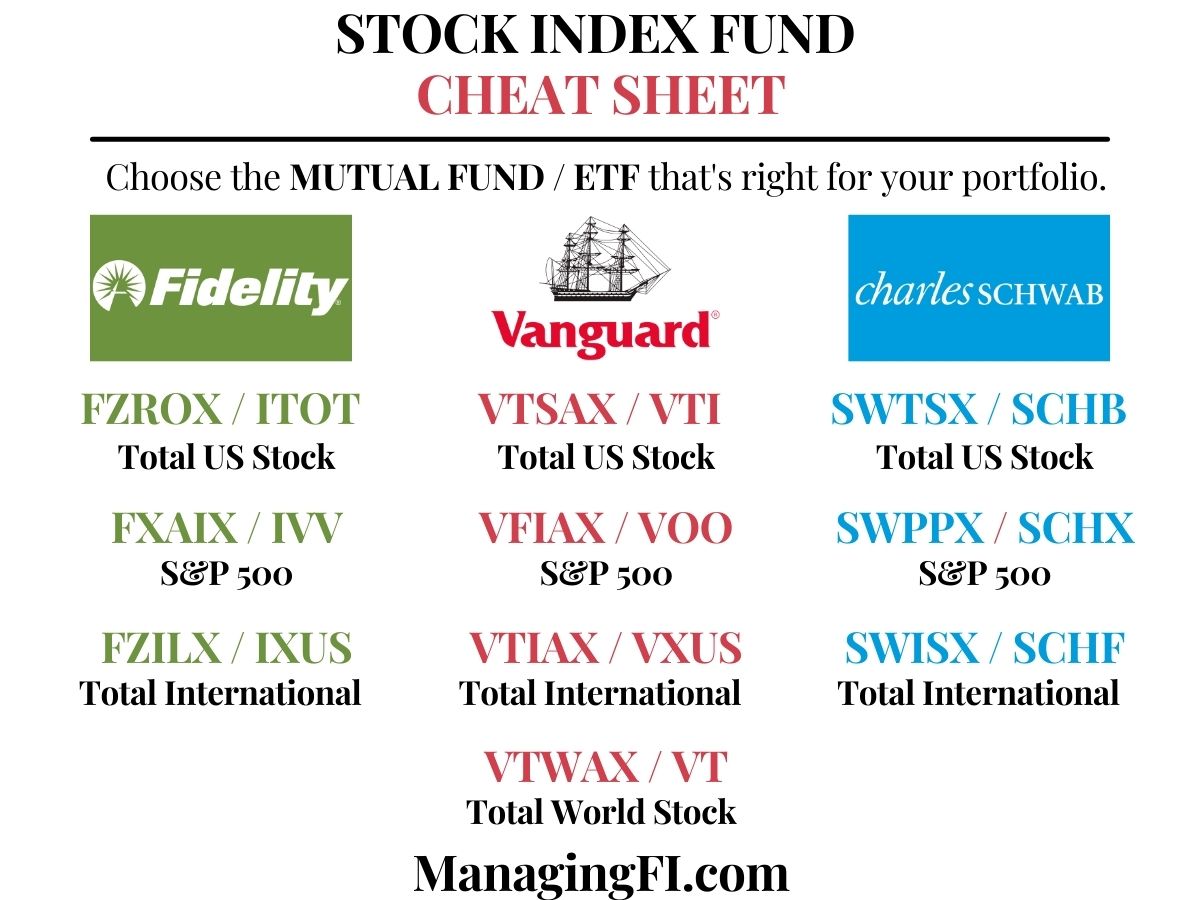
Cheat sheet for bond index funds:
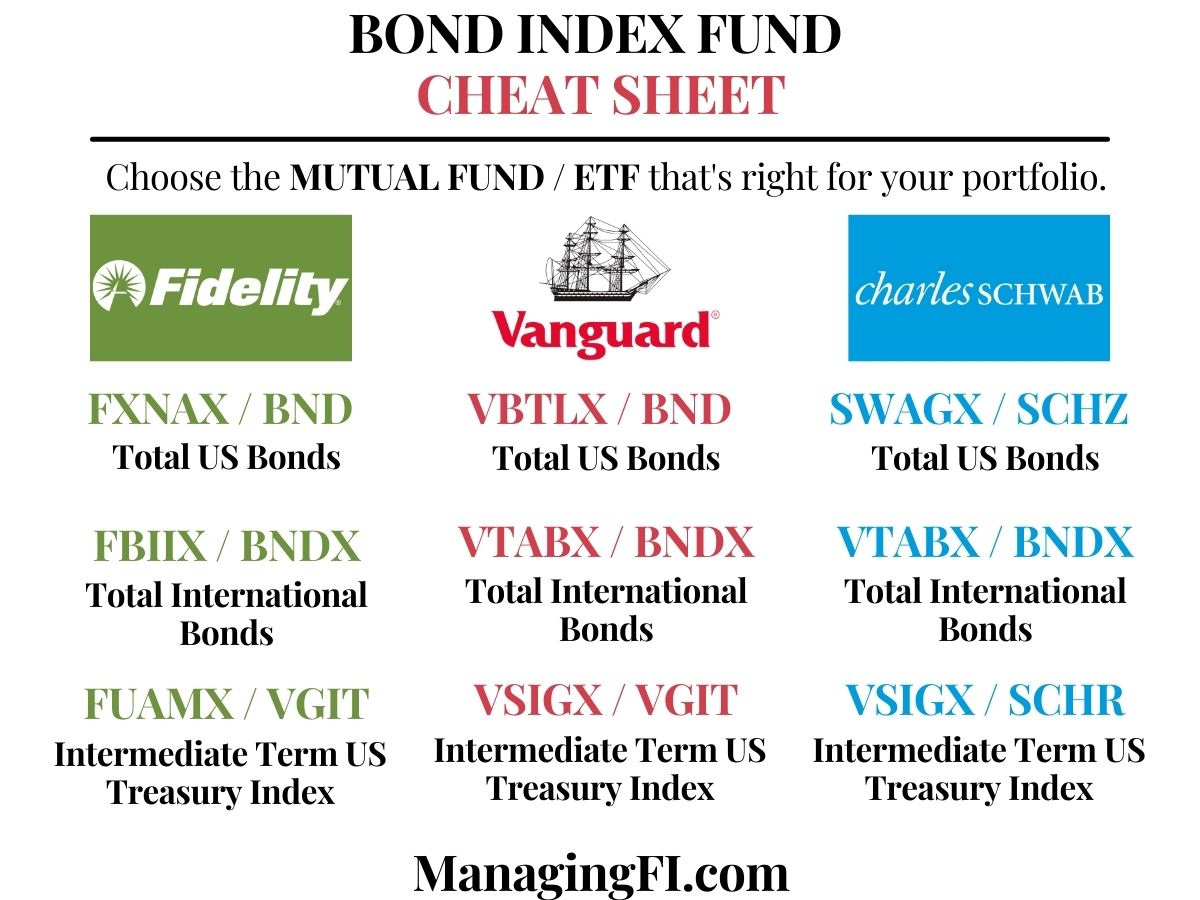
Actively managed funds that go into more exotic strategies and asset classes are also available in both types of funds as well.
Fidelity alone has 9,577 different mutual funds available with 9,165 of those being actively managed funds. The remaining 412 are index fund options. In other words, they’ve invented every possible way to try and get your money with the hope of superior returns.
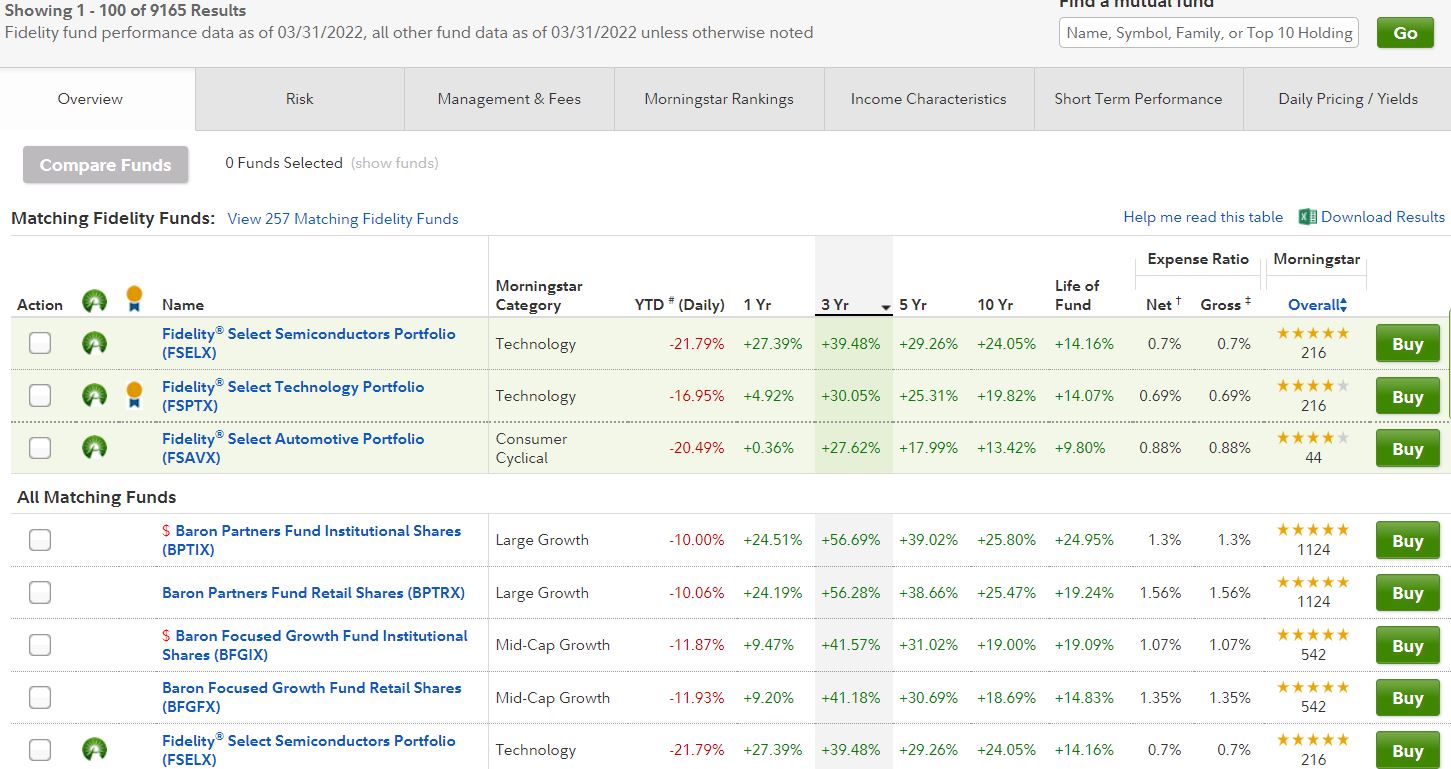
Mutual Fund and Exchange Traded Fund (ETF) – The Differences
Despite how similar these fund types are, there are distinct difference in how they’re traded, taxed and handled on different brokerage platforms.
Liquidity
Liquidity describes how fast and easy it is to get into (buy) or out of (sell) an investment. Mutual funds one have one buy and sell price per day which is established after the market closes on 4pm EST, Monday – Friday.
You can’t buy or sell mutual funds in the middle of the trading day. If you submit an order for VTSAX, the total stock market mutual fund on Tuesday at 6pm, it will be executed on Wednesday after 4pm when the market closes.
That’s why a mutual fund chart looks like a bunch of dashes if you try to view it as a candlestick chart. Here is an example of that with VTSAX.
ETF’s on the other hand trade like stocks. You can buy and sell them at any time during the trading day (9:30am – 4pm EST are the normal exchange hours).
You can see this in the candlestick chart for the ETF VTI (ETF equivalent of VTSAX). Each day the prices fluctuate with the height of the candle showing the price movement for the day.
For that reason ETFs have a bit more liquidity. Generally this isn’t a big issue for a long term investor but if you have something time sensitive and need to sell investments that day then the ETF’s will buy you hours.
Tax Treatment

Mutual funds have more taxable events, especially capital gains and losses, that pass through to the holders of those mutual funds. This is important to know if you hold mutual funds in a taxable brokerage account.
The likelihood of substantial capital gains is very low with an index mutual fund but much more likely with actively managed mutual funds. That said, the massive tax debacle with Vanguard target date funds where people were hit with huge tax bills without any real gains highlights the tax risk.
It’s important to understand that mutual funds distribute capital gains for all people holding the fund near the end of the year. It’s entirely possible that you buy a mutual fund in August and are hit with capital gains distributions in December for gains that you never saw in your account.
ETF’s on the other hand generally don’t distribute capital gains or losses during normal circumstances. The capital gains stay within the fund and you realize those gains when you sell your appreciated ETF shares. No surprises.
In both mutual funds and ETF’s the dividends are passed through to the owner. They’re considered qualified dividends taxed at long term capital gains rates if you held the fund for at least 60 days. Otherwise they’re unqualified dividends and taxed at your ordinary income tax rate.
More info on ETF taxation here if you’re interested.
Investing Minimums
Mutual funds typically have a minimum amount of money that is required before you can invest in that fund. This is often in the low thousands of dollars. For example, the ever popular VTSAX has a minimum of $3,000 to invest in it.

However, ETFs are much more accessible. The investment minimum used to be the price of a single share. For example the ETF equivalent of VTSAX, VTI, is currently trading at $225/share.
However, these days almost all brokerages allow you to buy fractional shares. This often means that you can invest in these ETFs even if you have only $5 or $10!
Here’s an example of that buying VTI. I didn’t have $225 in my account for a full share but with my $150 I was able to buy 0.6667 shares.
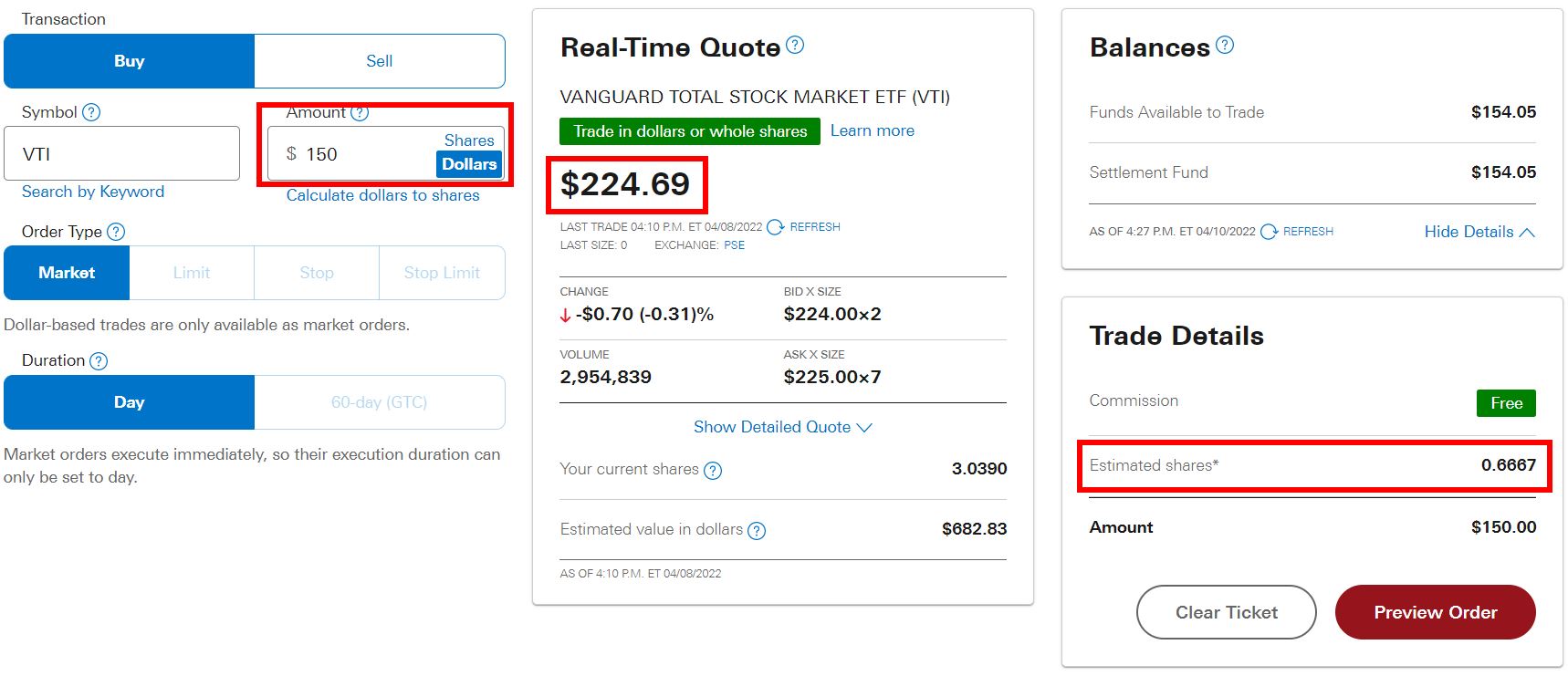
Portability Of Investments
Portability of investments is talking about how easily you could move your account with investments from one brokerage to another. For retirement accounts this is a non-issue because you can sell assets without tax consequence and move the account in cash.
However, this is an important consideration for a taxable brokerage account since you can’t just sell your assets to cash without creating a huge tax event. The desired approach is to transfer the assets “in kind”. This means that you hold onto your shares and move them from Vanguard to Fidelity, for example.
With mutual funds, this can problematic. The receiving brokerage account must off the mutual fund that you want to move for them to let you move it. For example, Vanguard doesn’t offer Fidelities most popular FZROX total market fund because it competes with VTSAX. You wouldn’t be able to move those shares from a Fidelity taxable account directly to a Vanguard taxable account.
If they do let you buy another brokerages mutual funds, watch out for fees. Here is Fidelity charging $75 for a one time buy of Vanguards VTSAX. Yikes!
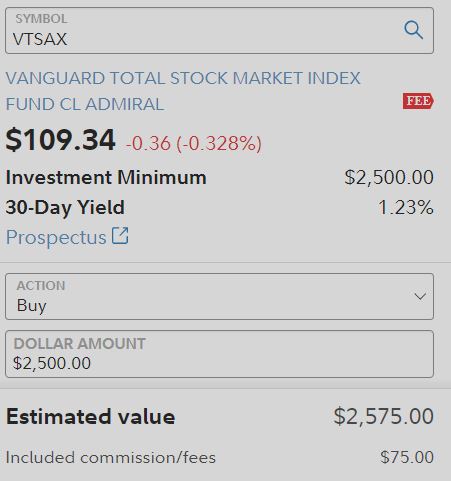
ETFs, however, are much more universally available across platforms. It might be an issue if you own very niche ETF’s but all the major index ETFs should be no issue. It becomes an easy thing to transfer assets in kind in the ETF world.
I’ve heard that Vanguard will let you convert your mutual funds to their ETF equivalent without tax consequence within a brokerage account. I’m thinking about doing this myself in the near future and will report back if I learn anything in the process.
Why might you want to move investment assets?
- Consolidate accounts under one brokerage to make things simpler and easier to manage.
- Move assets to platforms with more advanced features like M1 with their fancy auto rebalancing using investing allocation “pies”.
- Move assets to other platforms where you can borrow cheaply against your investment assets on margin to give yourself a low interest loan. M1 finance and interactive brokers both offer cheap margin loans.
Ease Of Automatic Investing

As I’ve previous written, one way I avoid investment mistakes is to automate my investing as much as possible. Mutual funds makes this very simple as you can setup an automatic schedule to invest like clockwork into your accounts. Example below from my Vanguard account that executes monthly.

ETF’s only trade during market hours and some platforms won’t let you setup to do automatic investing using ETFs. Vanguard and Fidelity won’t let you right now. M1 will I’m told. So, it’s hit or miss.
Here’s an example of me trying to buy an ETF on Vanguard on a Sunday afternoon. Denied!

Investment Fees:
In general, the fees on ETFs are all lower than their mutual fund equivalients. Here’s are a could of examples of a total stock market fund (red) and total bond fund (blue). The mutual funds VTSAX and VBTLX on the left and the ETFs VTI and BND on the right. You can see that they’re just a little bit cheaper.

That said, it’s a really a trivial amount of money in this case so for these funds I wouldn’t use that to drive my decision making. A 0.1% or 0.2% difference would make me think twice though.
Mutual Funds vs. ETFs – Picking The Best Option For You
I’ve given you a lot to consider in describing the features and limitations of each investment type. Lets summarize some of the advantages of each:
ETF Advantages
- More portable – can be transferred in kind to almost any brokerage without liquidation.
- No complicated fee structures. Just the expense ratio which is typically lower than the mutual fund equivalent.
- More tax efficient – few taxable events passed to you.
- More liquid – trades like a stock.
- Lower investment minimums.
Mutual Fund Advantages
- You can automate investing at the big 3 brokerages.
- Fund availability – there are many more mutual fund options than ETFs. Fidelity, for example, offers 10,000 mutual funds but only 2,700 ETFs. You might not find what you want in ETF form or you might not have any ETF options in your retirement account.
Which Is Right For You?
That’s up for you to decide! One thing to keep in mind is to make sure you get the big things right. Avoiding investing mistakes, maximizing time in the market, low fees and simplicity are factors that I consider quite important.
What Do I Use?
I currently use all mutual funds in my Vanguard brokerage account.

Why? The automatic investing option is really what’s driving that decision above all. I love automation to reduce my work and to remove my brain from tactical decision making.
I trust Vanguard as an institution and love their low fee products. If there was an automatic way to invest ETFs I would go that route all the way. I hope that’s an enhancement that they add soon.
The whole Vanguard target date tax bomb fiasco in 2022 has made me think twice about sticking with mutual funds. I am debating flipping the account to ETFs but haven’t pulled the trigger yet. Partially because I think that a future tax bomb risk is low. This is really bad PR for Vanguard so I’ll be shocked if they don’t make a systemic change to prevent a repeat of this situation.
Like the content? Click here to subscribe to the e-mail list and have the articles delivered to your inbox.

